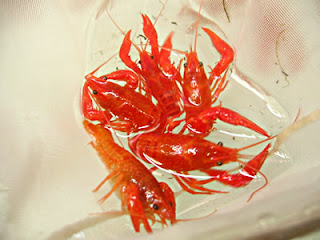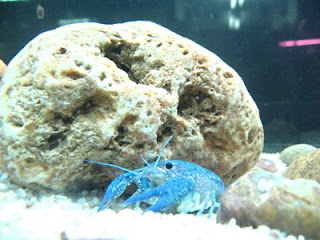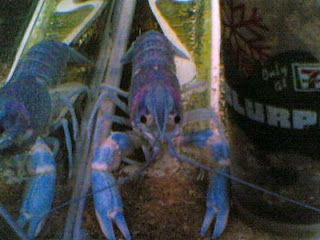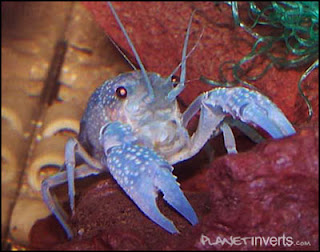 Crayfish and lobsters can be found in a variety of cooler waters, and there have been some problems with crayfish making an overpowering appearance outside of their native waters. For that reason certain species can be hard to find in aquatics centres, and you may need a licence to keep non-native specimens. All varieties sport glorious colours, they are however best kept in a specimen or species aquarium. Their aquarium should be furnished with rocks and plastic plants and roots as real plants will be destroyed. If more than one crayfish is to be kept in a tank they will need a lot of space as they are both territorial and cannibalistic. Also after a cray has moulted it becomes very vulnerable, if it is kept with anything that may attack it (like another crayfish) then the cray should be removed/separated until the carapace hardens. Crayfish are nocturnal and are best viewed after lights out, they should also be fed around lights out until they adopt a diurnal existence. They will readily hand feed once settled. Feed an omnivorous diet, including shrimp pellets, small fish, lean meats, worms, cockles and other frozen foods. Any uneaten food should be removed quite quickly as they have a tendency to hide hoards of food.
Crayfish and lobsters can be found in a variety of cooler waters, and there have been some problems with crayfish making an overpowering appearance outside of their native waters. For that reason certain species can be hard to find in aquatics centres, and you may need a licence to keep non-native specimens. All varieties sport glorious colours, they are however best kept in a specimen or species aquarium. Their aquarium should be furnished with rocks and plastic plants and roots as real plants will be destroyed. If more than one crayfish is to be kept in a tank they will need a lot of space as they are both territorial and cannibalistic. Also after a cray has moulted it becomes very vulnerable, if it is kept with anything that may attack it (like another crayfish) then the cray should be removed/separated until the carapace hardens. Crayfish are nocturnal and are best viewed after lights out, they should also be fed around lights out until they adopt a diurnal existence. They will readily hand feed once settled. Feed an omnivorous diet, including shrimp pellets, small fish, lean meats, worms, cockles and other frozen foods. Any uneaten food should be removed quite quickly as they have a tendency to hide hoards of food.
In the more evolved form of reproduction, the fry are usually born as miniature versions of the adults. Usually limited to crayfish and shrimp, it is also found in some species of crabs; namely the Potamon family of land crabs.
The larvae will hatch after up to 28, days and the young are almost fully-formed within the eggs during this time. Once born the only anatomical feature not present is the reproductive organs.
They eat almost the same food as the parents (just scaled down in size), and will develop and grow very quickly.

They are usually fairly easy to breed under aquarium conditions, and will be cared for by their mother until released (when some cannibalism may occur).
As the more specialised fry have a much better survival rate than the primitive fry, the females produce fewer eggs (from only 7 up to 300 depending on species and condition) making the numbers more manageable.

The most important stage of their development is their first 24 hour period, during this time the fry will undergo their first moult, and many will not survive. Only the fry that survive the first two weeks have a good change of reaching adulthood.
The water should be changed frequently during this period, and quality needs to be kept good to assure a higher survival rate.

Some species, like the long-arm shrimp, will be born as floating larvae, and will only start crawling after this period. These species need to be fed small live feeds such as newly hatched brine shrimp or microworms, or Liquifry type foods, but care should be taken to ensure the water doesn't become too polluted.
The juveniles will look very different in colour to the parents, usually appearing transparent and well camouflaged. Their colours will change only when they reach sexual maturity, and start to attract a mate. Some species, especially crayfish, may predate on their smaller siblings too, so you may need to segregate them as they grow.
The mating process is rarely witnessed, the only evidence that it has happened is the eggs held within the females pleopods.
During the ritual, the males will attract (or entrap) a female, and they will copulate in the 'Y' position for a short time, continually cleaning and preening each other throughout.
Cherax holthuisi

Cherax zebra

Cherax sp. Tricolor

Cherax sp. blue moon

Cherax sp. redbrick

Cherax destructor

Procambarus clarkii blue

Procambarus clarkii

Procambarus clarkii orange ( My Cray :P )

Procambarus clarkii white ( My Cray too)

Cherax sp. Orange Tip

Cherax Preissii Black jet

credit from http://www.shrimpcrabsandcrayfish.co.uk/
No comments:
Post a Comment